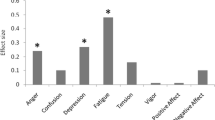Abstract
Background: Dance and yoga have been shown to produce improvements in psychological well-being.Purpose: The aim of this study was to examine some of the psychological and neuroendocrine responses to these activities.Methods: Sixty-nine healthy college students participated in one of three 90-min classes: African dance (n = 21), Hatha yoga (n = 18), or a biology lecture as a control session (n = 30). Before and after each condition participants completed the Perceived Stress Scale (PSS), completed the Positive Affect and Negative Affect Schedule, and provided a saliva sample for cortisol.Results: There were significant reductions in PSS and negative affect (ps < .0001) and Time × Treatment interactions (ps < .0001) such that African dance and Hatha yoga showed significant declines, whereas there was no significant change in biology lecture. There was no significant main effect for positive affect (p = .53), however there was a significant interaction effect (p < .001) such that positive affect increased in African dance, decreased in biology lecture, and did not change significantly in Hatha yoga. There was a significant main effect for salivary cortisol (p < .05) and a significant interaction effect (p < .0001) such that cortisol increased in African dance, decreased in Hatha yoga, and did not change in biology. Changes in cortisol were not significantly related to changes in psychological variables across treatments. There was 1 significant interaction effect (p = .04) such that change in positive affect and change in cortisol were negatively correlated in Hatha yoga but positively correlated in African dance and biology.Conclusions: Both African dance and Hatha yoga reduced perceived stress and negative affect. Cortisol increased in African dance and decreased in Hatha yoga. Therefore, even when these interventions produce similar positive psychological effects, the effects may be very different on physiological stress processes. One factor that may have particular salience is the amount of physiological arousal produced by the intervention.
Similar content being viewed by others
References
Hoffman C, Rice D, Sung HY: Persons with chronic conditions: Their prevalence and costs.Journal of the American Medical Association. 1996,276:1473–1479.
Mayer EA, Craske M, Naliboff BD: Depression, anxiety, and the gastrointestinal system.Journal of Clinical Psychiatry. 2001,62:28–37.
Johnston-Brooks CH, Lewis MA, Evans GW, Whalen CK: Chronic stress and illness in children: The role of allostatic load.Psychosomatic Medicine. 1998,60:597–603.
Wolkowitz OM, Epel ES, Reus VI: Stress hormone-related psychopathology: Pathophysiological and treatment implications.World Journal of Biological Psychiatry. 2001,2: 115–143.
Eisenberg DM, Davis RB, Ettner SL, et al.: Trends in alternative medicine use in the United States, 1990–1997: Results of a follow-up national survey.Journal of the American Medical Association. 1998,280:1569–1575.
Berger BG, Owen DR: Mood alteration with yoga and swimming: Aerobic exercise may not be necessary.Perception and Motor Skills. 1992,75:1331–1343.
Schmidt T, Wijga A, Von Zur Muhlen A, et al.: Changes in cardiovascular risk factors and hormones during a comprehensive residential three month kriya yoga training and vegetarian nutrition.Acta Physiologica Scandinavica. 1997,640(Suppl.): 158–162.
Garfinkel MS, Singhal A, Katz WA, et al.: Yoga-based intervention for carpal tunnel syndrome: A randomized trial.Journal of the American Medical Association. 1998,280:1601–1603.
Schell FJ, Allolio B, Schonecke OW: Physiological and psychological effects of Hatha-yoga exercise in healthy women.Internation Journal of Psychosomatics. 1994,41:46–52.
Kamei T, Toriumi Y, Kimura H, et al.: Decrease in serum cortisol during yoga exercise is correlated with alpha wave activation.Perception and Motor Skills. 2000,90:1027–1032.
Cruess DG, Antoni MH, Kumar M, Schneiderman N: Reductions in salivary cortisol are associated with mood improvement during relaxation training among HIV-seropositive men.Journal of Behavioral Medicine. 2000,23:107–122.
Field T, Ironson G, Scafidi F, et al.: Massage therapy reduces anxiety and enhances EEG pattern of alertness and math computations.International Journal of Neuroscience. 1996,86: 197–205.
McKinney CH, Antoni MH, Kumar M, et al.: Effects of guided imagery and music (GIM) therapy on mood and cortisol in healthy adults.Health Psychology. 1997,16:390–400.
Lane AM, Lovejoy DJ: The effects of exercise on mood changes: The moderating effect of depressed mood.Journal of Sports Medicine and Physical Fitness. 2001,41:539–545.
Bartholomew JB, Miller BM: Affective responses to an aerobic dance class: The impact of perceived performance.Research Quarterly for Exercise and Sport. 2002,73:301–309.
Cohen SO, Walco GA: Dance/movement therapy for children and adolescents with cancer.Cancer Practice. 1999,7:34–42.
Noreau L, Martineau H, Roy L, Belzile M: Effects of a modified dance-based exercise on cardiorespiratory fitness, psychological state and health status of persons with rheumatoid arthritis.American Journal of Physical and Medical Rehabilitation. 1995,74:19–27.
Howlett TA: Hormonal responses to exercise training: A short review.Clinical Endocrinology. 1987,26:723–742.
Dickerson S, Kemeny ME: Acute stressors and cortisol responses: A theoretical integration and synthesis of laboratory research.Psychological Bulletin. 2004,130:355–391.
Cohen S, Kamarck T, Mermelstein R: A global measure of perceived stress.Journal of Health and Social Behavior. 1983,24:386–396.
Watson D, Clark LE, Tellegen A: Development and validation of brief measures of positive and negative affect: The PANAS scales.Journal of Personality and Social Psychology. 1988,54:1063–1070.
Buchanan TW, al’ Absi M, Lovallo WR: Cortisol fluctuates with increases and decreases in negative affect.Psychoneuroendocrinology. 1999,24:227–241.
Clark L, Iversen SD, Goodwin GM: The influence of positive and negative mood states on risk taking, verbal fluency, and salivary cortisol.Affective Disorders. 2001,63:179–187.
Perna FM, Antoni MH, Kumar M, Cruess DG, Schneiderman N: Cognitive-behavioral intervention effects on mood and cortisol during exercise training.Annals of Behavioral Medicine. 1998,20:92–98.
Author information
Authors and Affiliations
Corresponding author
Additional information
This research was supported by grants from the General Clinical Research Center of Oregon Health Sciences University and Reed College.
About this article
Cite this article
West, J., Otte, C., Geher, K. et al. Effects of hatha yoga and african dance on perceived stress, affect, and salivary cortisol. ann. behav. med. 28, 114–118 (2004). https://doi.org/10.1207/s15324796abm2802_6
Issue Date:
DOI: https://doi.org/10.1207/s15324796abm2802_6




